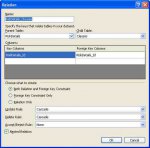I have a Dataset, and must generate some XML. The XML used to output like this:
A)
From my dataset it looks like
B)
I've attached the design and what the relationship looks like.
What must I change to get it to look like (A) again?
Thanks
A)
VB.NET:
- <Clauses>
<ClauseCode>TM004</ClauseCode>
<ClauseCode>TM005</ClauseCode>
<ClauseCode>TM012</ClauseCode>
</Clauses>
</RiskDetails>From my dataset it looks like
B)
VB.NET:
- <Clauses>
<ClauseCode>TM004</ClauseCode>
</Clauses>
- <Clauses>
<ClauseCode>TM005</ClauseCode>
</Clauses>
- <Clauses>
<ClauseCode>TM012</ClauseCode>
</Clauses>
</RiskDetails>I've attached the design and what the relationship looks like.
What must I change to get it to look like (A) again?
Thanks


